OMB ‘Supports’ Extra LCS, But Where’s The Money?
Posted on
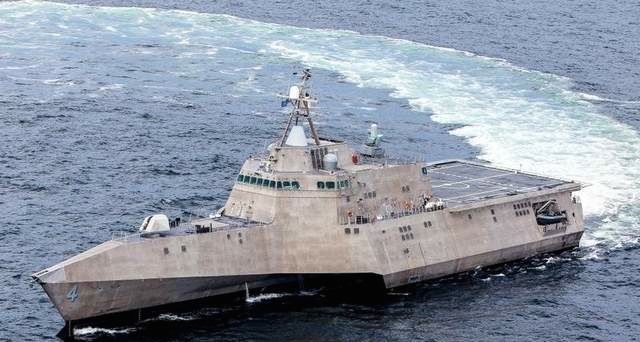
LCS-4, USS Coronado
UPDATE: Source Says WH Will Fund LCS Add; CRS Naval Expert Comments
CAPITOL HILL: In a startling turnabout, the Trump Administration now “supports” adding a $541 million Littoral Combat Ship to yesterday’s 2018 budget request, Navy officials told Congress this afternoon. What, exactly, does that mean? The Navy doesn’t know.
Minutes before Navy witnesses were to testify before the House seapower subcommittee, they were given new language from the White House Office of Management & Budget: “The Administration recognizes the criticality of our industrial base and supports funding a second LCS in FY18.” OMB gave them no information, however, about whether “supports” is a promise of new money or just a vague sentiment that Congress should feel free to increase the Navy budget.
UPDATE BEGINS: The money will come, promised a source familiar with the administration’s discussions. “The administration’s going to support two (Littoral Combat) ships in the budget in FY18, and we’re figuring out the mechanism to do that,” the source assured me. “There will be a document of some sort, some sort of statement indicating that the administration is going to include in its budget request two LCS in ’18.” The administration will also probably urge the Hill to add a third LCS, leaving it up to Congress to find the funding for that ship.
Where’s the money coming from for the second LCS, the one the administration is funding? “That is a question for which I do not have an answer,” the source admitted. “OMB and DoD are going to have to sort that out. All I can say is, it will be there.”
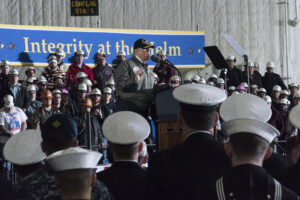
President Trump speaks to Newport News Shipbuilding employees above the carrier FORD.
Land of Confusion
This was a pretty confusing way to get something in the budget, I said.
“Yeah. I don’t disagree,” said the source, chagrinned. “I wish that it had been done differently the whole way, (but) LCS is a controversial ship, and there are plenty of people who have concerns about it. (At DoD), I think they viewed LCS as a bill payer for other priorities.”
Ultimately, “the senior people in the administration said, we’re going to make the industrial base for our navy…a priority,” the source said, but by that point, “it was too late to put it in the physical budget document that were printed…The decision to include came rather late in the process and communicating that to the Navy and DoD writ large was a little delayed.” UPDATE ENDS
Confusion certainly reigned on the Hill this afternoon. After the seapower hearing, reporters swarmed star witness Allison Stiller, a career civil servant who’s “performing the duties of” the assistant Navy secretary for research, development, and acquisition in the absence of a permanent appointee. (Trump’s staffing problems are another aspect of the new administration’s departure from established Washington procedure).
“You heard me say that the administration is supportive of a second LCS,” Stiller told us. “That was brought to us today, and that’s what I know.”
“Supportive” isn’t exactly budgetary terminology, I noted.
“I’m relaying what I was asked to relay,” said the beleaguered Stiller.
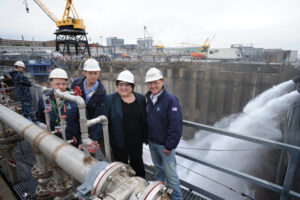
Allison Stiller overseeing float-off of the attack submarine USS Mississippi.
So, one of us asked, will the money for the ship be taken from other Navy programs?
“We don’t have those details yet,” said Vice Admiral William Lescher, Deputy Chief of Naval Operations.
Were you surprised to get this change from OMB?
“That’s OMB’s prerogative,” Stiller said.
Do you have any idea where the money’s coming from?
“What I said is the administration is supportive of the second ship,” said the increasingly strained Stiller. “I do not know the details. I do not know how that’s going to manifest itself.”
“And that’s all we really have on that,” a Navy public affairs officer interjected, urging the reporters on to other topics.
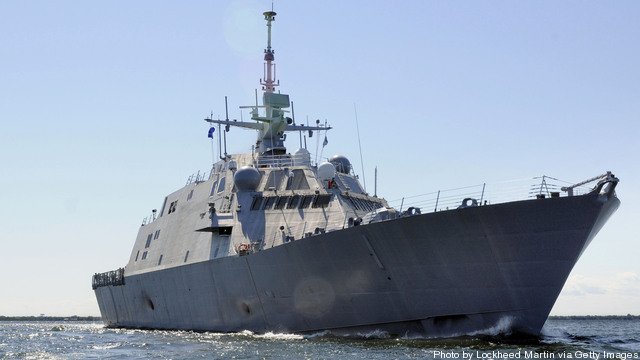
LCS-1, the USS Freedom
“Never Seen Anything Like This”
Without exception, reporters and other Washington veterans that I talked to expressed bemused disbelief. They couldn’t remember an administration proposing such a vague but dramatic change to its own budget within 24 hours of rolling it out.

Ron O’Rourke
UPDATE BEGINS: “This is the fastest de facto budget amendment I can recall, at least for the Navy programs that I cover,” said Ronald O’Rourke, the widely respected naval analyst for the non-partisan Congressional Research Service. “It came within a day or two of the budget being submitted, and only about three hours after the Navy had defended the one-ship request during the Q&A part of the SAC-D (Senate Appropriations defense subcommittee) hearing on the FY18 (Navy) budget.”
“As I understand it, the Navy is now requesting two LCSs for FY18, even though the Navy’s FY18 budget as submitted funds one LCS,” O’Rourke said. But, he said, whether the required funding, some $541 million, will have to come out of other Navy programs is still unclear.UPDATE ENDS
“I’ve never seen anything like this in the eight-nine budgets I’ve been involved in,” agreed one Pentagon official.
“Late in the budget endgame,” the official confirmed, a second Littoral Combat Ship was definitely under discussion between OMB, the Navy, and the Office of the Secretary of Defense, as we reported. Trump had promised a build-up to a 350-ship Navy, and LCS is the smallest and cheapest seagoing warship in the fleet (about 3,400 tons and $550 million), so adding an LCS is literally the least Trump could do to show progress towards that promise. But the administration decided to stick with one LCS and seven other naval vessels, the same eight-ship buy that the Obama administration had planned for 2017.

Adm. John Richardson
There were persistent rumors that OMB would add a second LCS, but Navy officials I spoke to yesterday denied them. Just this morning, the Chief of Naval Operations, Adm. John Richardson, and the acting Navy Secretary, Sean Stackley, got hammered in the Senate Appropriations Committee about the shortcomings of the shipbuilding budget, and they never mentioned a second LCS. (US Naval Institute News reports the plan was for Richardson and Stackley to make the announcement, but they weren’t told in time). Stiller herself doesn’t seem to have known until shortly before today’s 2:00 pm hearing, since she had to revise her written statement to include the added Littoral Combat Ship. House seapower chairman Rob Wittman hadn’t heard, because his opening remarks lambasted the administration for only building one LCS, which would lead to “massive layoffs” at both shipyards involved.
“It was unclear to what degree Stackley and Richardson knew about the switch,” the Pentagon official told me. “Sometime between the CNO’s testimony (in the morning) and Ms. Stiller and Vice Adm. Lescher’s testimony (in the afternoon), OMB told the Navy to articulate the new position.”

Marinette Marine shipyard in Wisconsin.
Results vs. Process
On the one hand, in a defense world where it can take years of legislative and bureaucratic wrangling to change an established program, it’s refreshing to see an administration respond to criticism and change course literally overnight. On the other hand, it’s alarming to see such poor communication between the White House and the Navy. And it’s confusing to see such vague, ad hoc pronouncements where taxpayer dollars and national security are involved.
If OMB really wants to add a ship to the budget request, there’s a well-established process for submitting a budget amendment. This isn’t it. If OMB just wants to encourage Congress to add the ship itself, well, Congress wasn’t waiting for the White House.
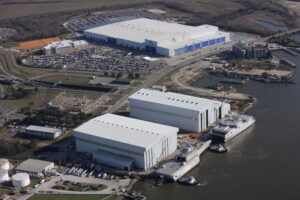
Austal’s shipyard in Mobile, Alabama.
UPDATE BEGINS But even the Hill needs help, argued the source familiar with administration discussions. “If one (LCS) is in the budget and you’re trying to get three total, the Hill would struggle to find the money to add two. That’s a huge lift for the appropriators, the authorizers,” the source argued. “If two are in the request and they just have to find one…they can bridge that gap.” The Hill’s successfully added single ships in past years on many occasions, both LCS and other classes.
So, the source concluded, “the Hill is now in a position to ensure that we have the minimum sustainment rate of three, and there will be no layoffs, and we can move on to the frigate program with no disruption.” The Navy wants both LCS shipyards, Austal in Alabama and Marinette Marine in Wisconsin, in good shape to compete against both each other and other yards for a more powerful but still-small warship called a frigate.
“All I can say is, the process may not have been ideal, but the end result is far, far better than if we had had a simple process and we had layoffs in Wisconsin and Alabama,” the source said. “So I would trade a little bit of a haphazard process for a robust industrial base and employed shipyard workers.”
Subscribe to our newsletter
Promotions, new products and sales. Directly to your inbox.
